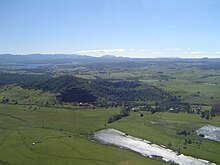Mount Quincan: Difference between revisions
Jimmybob32 (talk | contribs) No edit summary |
Mitch Ames (talk | contribs) Merge adjacent links per MOS:SEAOFBLUE |
||
| (31 intermediate revisions by 26 users not shown) | |||
| Line 1: | Line 1: | ||
{{Short description|Mountain in Queensland, Australia}} |
|||
| ⚫ | |||
{{Use Australian English|date=June 2020}} |
|||
| ⚫ | |||
{{Use dmy dates|date=July 2019}} |
|||
{{Infobox mountain |
|||
| name = Mount Quincan |
|||
| other_name = |
|||
| photo = |
|||
| photo_size = |
|||
| photo_alt = |
|||
| photo_caption = |
|||
| elevation = |
|||
| elevation_m = |
|||
| elevation_ft = |
|||
| elevation_ref = |
|||
| prominence = |
|||
| prominence_m = |
|||
| prominence_ft = |
|||
| prominence_ref = |
|||
| listing = |
|||
| range = |
|||
| parent_peak = |
|||
| location = [[Queensland]], [[Australia]] |
|||
| map = |
|||
| map_alt = |
|||
| map_caption = |
|||
| map_relief = |
|||
| map_size = |
|||
| label = |
|||
| label_position = |
|||
| coordinates = {{coord|17|18|11|S|145|34|39|E|display=inline,title}} |
|||
| coordinates_ref = |
|||
| grid_ref_UK = |
|||
| grid_ref_Ireland = |
|||
| topo = |
|||
| type = |
|||
| volcanic_arc/belt = |
|||
| age = |
|||
| last_eruption = |
|||
| first_ascent = |
|||
| easiest_route = |
|||
| child = |
|||
| embedded = |
|||
}} |
|||
[[File:Mt Quincan.jpg|alt=Mt Quincan, viewed from the south, showing the southern quarry with the main scoria cone behind it to the west and the low-lying crater to the east.|thumb|Mt Quincan, viewed from the south.]] |
|||
| ⚫ | |||
The extinct volcano is one of many [[cinder cone]]s in the Atherton Tableland region.<ref name="invo">{{cite book |title=Intraplate Volcanism: In Eastern Australia and New Zealand |last=Johnson |first=Robert Wallace |year=1989 |publisher=Cambridge University Press |isbn=978-0521380836 |page=92 |url=https://books.google.com/books?id=4NBOn7ecZeAC |accessdate=21 November 2012 }}</ref> Its crater is approximately 500 m across, with the main cone being to the northwest. Several of the nearby [[Seven Sisters (Queensland)|Seven Sisters]] cinder cones also have their craters to the southeast, which is possibly due to the ash and scoria being blown to the northwest by the prevailing SE winds.<ref>{{Cite book|title=Rocks, Landscapes and Resources of the Wet Tropics|last=Lottermoser|first=B. G.|last2=Whitehead|first2=P. W.|last3=Nelson|first3=P. N.|last4=Beaman|first4=R. J.|publisher=Geological Society of Australia, Queensland Division|year=2008|isbn=9780975789483|location=Brisbane|pages=17}}</ref> Swamp deposits within the crater were dated at 7250 years old, making that the minimum age for Mt Quincan.<ref>{{Cite journal|last=KERSHAW|first=A. P.|date=1971|title=A POLLEN DIAGRAM FROM QUINCAN CRATER, NORTH-EAST QUEENSLAND, AUSTRALIA|journal=New Phytologist|language=en|volume=70|issue=4|pages=669–681|doi=10.1111/j.1469-8137.1971.tb02567.x|issn=0028-646X}}</ref> The scoria deposits also contain abundant mantle [[xenolith]]s of [[peridotite]].<ref>{{Cite journal|last=Whitehead|first=P. W.|last2=Stephenson|first2=P. J.|last3=McDougall|first3=I.|last4=Hopkins|first4=M. S.|last5=Graham|first5=A. W.|last6=Collerson|first6=K. D.|last7=Johnson|first7=D. P.|date=2007|title=Temporal development of the Atherton Basalt Province, north Queensland|journal=Australian Journal of Earth Sciences|language=en|volume=54|issue=5|pages=691–709|doi=10.1080/08120090701305236|issn=0812-0099}}</ref> |
|||
[[File:Mt Quincan aerial view.jpg|alt=Mt Quincan, viewed from the southeast, showing the southern quarry with the main scoria cone behind it and the low-lying crater to the east.|thumb|Mt Quincan, viewed from the southeast, showing the southern quarry with the main scoria cone behind it and the low-lying crater to the east.]] |
|||
Quincan, a type of [[Scoria]], is mined from the south west quadrant of the mountain.<ref>[http://quincanquarries.com.au/ Yungaburra Quarry]. Retrieved on 21 November 2012.</ref> Quincan is used in road construction, driveways, weed control and domestic gardening. |
|||
==References== |
|||
<references /> |
|||
==External links== |
|||
| ⚫ | |||
{{DEFAULTSORT:Quincan}} |
|||
| ⚫ | |||
[[Category:Mountains of Queensland]] |
[[Category:Mountains of Queensland]] |
||
[[Category: |
[[Category:Landforms of Far North Queensland]] |
||
| ⚫ | |||
{{Queensland-geo-stub}} |
{{Queensland-geo-stub}} |
||
Latest revision as of 09:56, 17 January 2023
| Mount Quincan | |
|---|---|
 | |
| Highest point | |
| Coordinates | 17°18′11″S 145°34′39″E / 17.30306°S 145.57750°E |
| Geography | |
| Location | Queensland, Australia |

Mount Quincan is a volcanic mountain near Yungaburra on the Atherton Tableland in Far North Queensland, Australia.
The extinct volcano is one of many cinder cones in the Atherton Tableland region.[1] Its crater is approximately 500 m across, with the main cone being to the northwest. Several of the nearby Seven Sisters cinder cones also have their craters to the southeast, which is possibly due to the ash and scoria being blown to the northwest by the prevailing SE winds.[2] Swamp deposits within the crater were dated at 7250 years old, making that the minimum age for Mt Quincan.[3] The scoria deposits also contain abundant mantle xenoliths of peridotite.[4]

Quincan, a type of Scoria, is mined from the south west quadrant of the mountain.[5] Quincan is used in road construction, driveways, weed control and domestic gardening.
References
[edit]- ^ Johnson, Robert Wallace (1989). Intraplate Volcanism: In Eastern Australia and New Zealand. Cambridge University Press. p. 92. ISBN 978-0521380836. Retrieved 21 November 2012.
- ^ Lottermoser, B. G.; Whitehead, P. W.; Nelson, P. N.; Beaman, R. J. (2008). Rocks, Landscapes and Resources of the Wet Tropics. Brisbane: Geological Society of Australia, Queensland Division. p. 17. ISBN 9780975789483.
- ^ KERSHAW, A. P. (1971). "A POLLEN DIAGRAM FROM QUINCAN CRATER, NORTH-EAST QUEENSLAND, AUSTRALIA". New Phytologist. 70 (4): 669–681. doi:10.1111/j.1469-8137.1971.tb02567.x. ISSN 0028-646X.
- ^ Whitehead, P. W.; Stephenson, P. J.; McDougall, I.; Hopkins, M. S.; Graham, A. W.; Collerson, K. D.; Johnson, D. P. (2007). "Temporal development of the Atherton Basalt Province, north Queensland". Australian Journal of Earth Sciences. 54 (5): 691–709. doi:10.1080/08120090701305236. ISSN 0812-0099.
- ^ Yungaburra Quarry. Retrieved on 21 November 2012.
External links
[edit]
